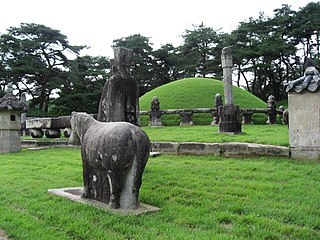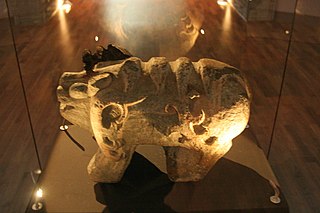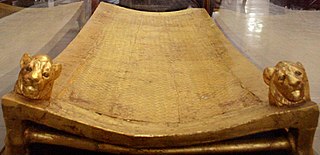Muryeong of Baekje was the 25th king of Baekje, one of the Three Kingdoms of Korea. During his reign, Baekje remained allied with Silla against Goguryeo, and expanded its relationships with China and Japan.
Ungjin, also known as Gomanaru is a former city on the Korean Peninsula. It was located in modern-day Gongju, South Chungcheong province, South Korea. It was the capital of Baekje from AD 475 to 538, during a period when Baekje was under threat from Goguryeo, the previous capital of Wiryeseong having been overrun. In 538, King Seong moved the capital to Sabi. Ungjin is now known as Gongju.

A National Treasure is a tangible treasure, artifact, site, or building which is recognized by the South Korean government as having exceptional artistic, cultural and historical value to the country. The title is one of the eight State-designated heritage classifications assigned by the administrator of the Cultural Heritage Administration (CHA) in accordance with the Cultural Heritage Protection Act after deliberation by the Cultural Heritage Committee.

Mireuksa was the largest Buddhist temple in the ancient kingdom of Baekje in the Korean Peninsula. The temple was established in 602 by King Mu and is located 36.012083 N, 127.031028 E, modern Iksan, North Jeolla Province, South Korea. The site was excavated in 1980, disclosing many hitherto unknown facts about Baekje architecture. Mireuksaji Stone Pagoda is one of two extant Baekje pagodas. It is also the largest as well as being among the oldest of all Korean pagodas.

The crowns of Silla were made in the Korean kingdom of Silla approximately in the 5th–7th centuries.

Gyeryongsan, a 845 m (2,772 ft) mountain in Chungcheongnam-do, South Korea. It lies at the meeting of the boundaries of several cities: Gongju, Gyeryong, Nonsan, and Daejeon. It has been traditionally regarded as a sacred mountain, with the most qi of any in South Korea. The name Gyeryongsan means chicken dragon mountain. Portions of the mountain are included in a South Korean military reserve. Other portions are part of Gyeryongsan National Park. In the mountain, there are famous Buddhist temples such as Donghaksa, Gapsa and Sinwonsa, the latter two both being over a thousand years old. In addition the highest peak, Cheonhwangbong, there are seven other peaks with an elevation exceeding 500m

Tourism in South Korea refers to the tourist industry in the Republic of Korea. In 2012, 11.1 million foreign tourists visited South Korea, making it the 20th most visited country in the world, and the 6th most visited in Asia. Most non-Korean tourists come from other parts of East Asia such as Japan, China, Taiwan, and Hong Kong. The recent popularity of Korean popular culture, often known as the "Korean Wave", in these countries has increased tourist arrivals. Seoul is the principal tourist destination for visitors; popular tourist destinations outside of Seoul include the major coastal city of Busan, the Seorak-san national park, the historic city of Gyeongju and subtropical Jeju Island. Traveling to North Korea is not normally possible without a special permission, but in recent years organized group tours have allowed groups of South Korean citizens to visit Mount Kumgang.

The National Museum of Korea is the flagship museum of Korean history and art in South Korea and is the cultural organization that represents Korea. Since its establishment in 1945, the museum has been committed to various studies and research activities in the fields of archaeology, history, and art, continuously developing a variety of exhibitions and education programs.

The Crown of Baekje refers to several artifacts excavated that are believed to be the royal headgear of the kings, queens, and nobility of the Baekje Kingdom. Some of the crowns follow the same tradition as Silla crowns in that they share the tree-motif and the hints of shamanistic traditions. However, the diadems of the kings and queens suggest that Baekje people had a distinct tradition for their royal headgear.

Cheonmachong, formerly Tomb No.155 in South Korea, is a tumulus located in Gyeongju, South Korea. The name "Cheonmachong" means Sky horse tomb. This tomb was built in the style of Silla. The tomb was excavated in 1973 and is believed to date probably from the fifth century but perhaps from the sixth century CE. The tomb was for an unknown king of the Silla Kingdom.

The Tomb of King Muryeong, also known as Songsan-ri Tomb No. 7, is the ancient tumulus of King Muryeong, who ruled the Baekje from 501 to 523, and his queen. The rarity of intact Baekje tombs makes this one of the major archaeological discoveries in Korea and a crucial source for the understanding of Baekje, one of the Three Kingdoms of Korea.

The Tombs of the Joseon Dynasty refers to the 40 tombs of members of the Korean Joseon Dynasty (1392–1910). These tombs are scattered in over 18 locations across Korea. They were built to honor and respect the ancestors and their achievements, and assert their royal authority. The tombs have been registered as a UNESCO World Heritage site since 2009.

Seoksu is a stone animal statue in the image of a beast, placed at or within a tomb or palace. This kind of protective stone animal originated from the funeral customs of the Eastern Han Dynasty. Seoksu could also be placed in the pile of the stone and rubble used to surround the tomb and can be found carved on the bases of pagodas.

Songguk-ri is a Middle and Late Mumun-period archaeological site in Buyeo-gun, Chungcheongnam-do, South Korea. Songguk-ri is a settlement and burial site that is important in the study of Korean prehistory. It is registered as Historical Site No. 249. Songguk-ri is a main point of reference in Korean prehistory—Korean archaeologists have represented the prehistoric village and the material culture excavated from there as the type-site for Middle Mumun Culture in southern Korea.

Exhibitions of artifacts from the tomb of Tutankhamun have been held at museums in several countries, notably the United Kingdom, Soviet Union, United States, Canada, Japan, and France etc.

The Suda Hachiman Shrine Mirror in Hashimoto, Wakayama, Japan is a National Treasure of Japan. It was cast with 48 Chinese characters around the fifth century. It is an important artifact for the research in Japanese archaeology and Old Japanese language.

The Museum of the Western Han Dynasty Mausoleum of the Nanyue King houses the 2,000-year-old tomb of the Nanyue King Zhao Mo in Guangzhou. Zhao Mo ruled from 137 BC to 122 BC, and his tomb was discovered in downtown Guangzhou in 1983. The museum, which opened in 1988, showcases the tomb and its complete trove of artifacts. It was named a Major National Historical Site in 1996 and is renowned for its rare assemblage of funerary artifacts representing the diffusion of cultures throughout the Lingnan region during the Han dynasty.

The Baekje Historic Areas are a group of monuments located in three South Korean cities: Gongju, Buyeo, and Iksan. They relate to the last period of the Baekje Kingdom, representing the period from 475 to 660 CE, which was one of the three kingdoms that flourished from 18 BC to 660 AD. The property designated as a UNESCO World Heritage Site has eight archaeological sites. These are: The Gongsanseong fortress and the royal tombs at Songsan-ri, related to the capital city of Ungjin, now Gongju; the Busosanseong Fortress (부소산성) and Gwanbuk-ri administrative buildings, the Jeongnimsa Temple, the Neungsan-ri royal tombs, and the Naseong city wall in Sabi, now Buyeo; and the Wanggung-ri Palace and the Mireuksa Temple in Iksan, a subsidiary capital region of Sabi.
Inmyeonjo is a mythological creature from Korea that appears as a bird with a human face. Most of them are women, and some are male.

The Watanuke Kannonyama Kofun (綿貫観音山古墳) is a Kofun period burial mound located in what is now the city of Takasaki, Gunma Prefecture in the northern Kantō region of Japan. The site was designated a National Historic Site of Japan in 1973.The site dates from the late 6th Century, and many of the grave goods discovered during archaeological excavation were designated National Important Cultural Properties in 1994 In the year 2020, the collective status of 3346 artifacts from the tomb was raised to that of a National Treasure.






















